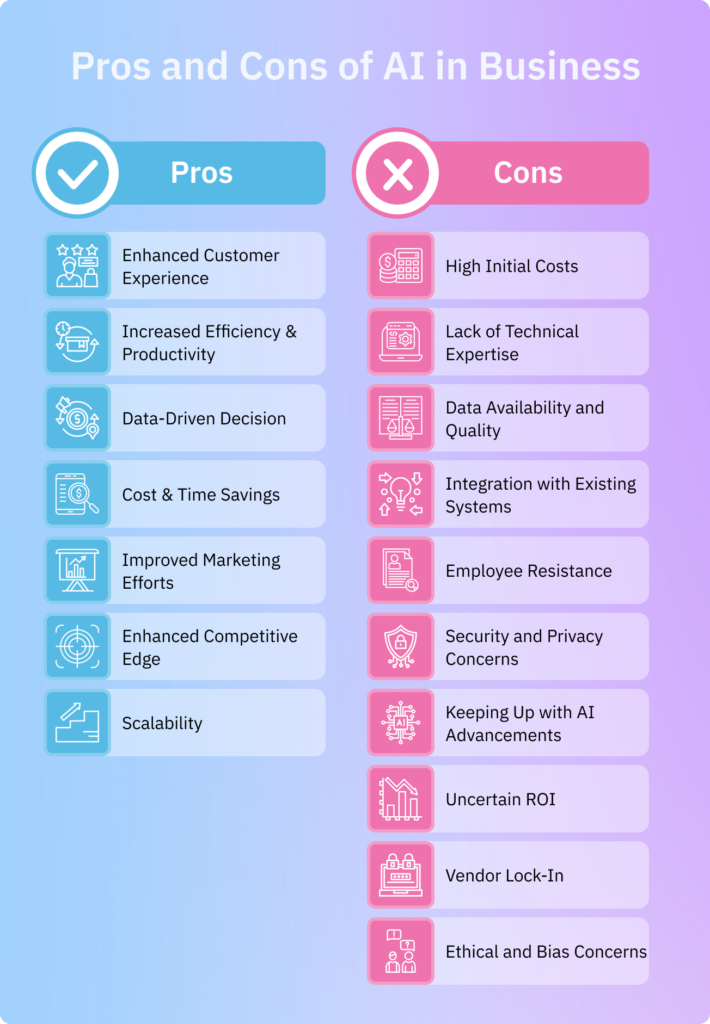
Unlocking Growth: The Benefits of AI Automation for Small Businesses
Estimated reading time: 8 minutes
Main Points
- AI automation is now accessible to small businesses due to reduced costs and increased availability.
- Enhances efficiency, reduces operational costs, and levels the playing field with larger competitors.
- Optimizes operations and frees up human resources for high-value tasks.
- Benefits include cost savings, improved decision-making, and scalability.
- Implementing AI automation is a strategic necessity for sustainable growth in SMEs.
Table of Contents
Understanding AI Automation for Small Businesses
Explanation of AI Automation
AI automation is about integrating artificial intelligence with automated systems to perform tasks that usually need human brainpower. This involves predictive analytics, customer service, and efficient operational processes, all executed without human intervention. For example, AI can handle data analysis, streamline customer interactions, and optimize daily operations, freeing up valuable human resources for other tasks.
Difference from General AI Solutions
General AI comprises broad capabilities akin to human intelligence, while AI automation is focused on enhancing efficiency through the automation of specific tasks. This makes AI automation particularly practical and valuable for small businesses, which can promptly implement these tools to improve their operations.
Value Specific to SMEs
AI automation benefits SMEs by optimizing operations while managing limited resources. It allows small businesses to scale operations seamlessly, bolster customer service, and tap into data-driven decision-making. These advantages enable SMEs to stand toe-to-toe with larger competitors, leveling the playing field. [Source]
Key Benefits of AI Automation for SMEs
A. Cost Savings and Return on Investment (ROI)
Reduction in Labor Costs
Automating repetitive tasks translates to substantial savings on labor costs, ranging from 30% to 50% reductions. This results in increased productivity with fewer resources spent on mundane tasks. [Elevato Digital] [Source]
Increase in Productivity
With tedious work handled by AI, employees can channel their efforts into strategic, impactful activities that drive business growth.
Faster ROI
Thanks to rapid implementation and efficiency gains, SMEs often see a positive return on investment from AI automation within just a few months.
B. Optimized Day-to-Day Operations
Automation of Repetitive Tasks
AI takes over routine tasks such as data entry, scheduling, and inventory management, streamlining operations and reducing errors. [SME South Africa]
Real-Time Insights
AI systems offer up-to-date analytics, enhancing decision-making accuracy by providing insights into daily operations.
Reduced Errors
With less human error, businesses experience improved accuracy in various administrative processes, leading to higher quality outcomes.
C. Freeing Up Human Resources
Focus on High-Value Work
AI automation liberates employees from the mundane, empowering them to focus on innovation and cultivating customer relationships.
Improved Employee Satisfaction
Engaging in meaningful work naturally increases job satisfaction and can lead to better employee retention rates.
Advantages of AI Automation Systems
A. Enhanced Customer Support with AI Chatbots
24/7 Availability
AI-powered chatbots deliver round-the-clock customer service, improving satisfaction and reducing the load on the human workforce. [CustomGPT] [Source]
Efficient Handling of Inquiries
By managing standard questions and transactions, chatbots allow human agents to address more complex customer needs.
B. Improved Decision-Making with Predictive Analytics
Data Analysis
AI systems can sift through massive data sets to identify trends and predict future market and business outcomes, creating a strategic advantage. [Sintex AI] [Source]
Strategic Planning
With predictive insights, businesses can better forecast demand and optimize inventory management.
C. Scalability and Adaptability
Growth Accommodation
AI automation platforms readily scale as businesses grow, efficiently managing additional demand with minimal costs. [Source]
Flexibility
These systems quickly adapt to the changing needs of a dynamic business environment.
Improving Efficiency with AI Automation
A. Streamlining Processes
Automated Invoicing
AI solutions can dramatically reduce invoicing processing times by up to 80%, allowing businesses to allocate resources more effectively. [U.S. Chamber of Commerce] [Source]
Email Marketing Automation
AI-powered tools increase engagement in email marketing campaigns by 40%, carving out new channels for customer interaction and engagement.
Scheduling and Task Management
AI tools efficiently manage schedules and task assignments, optimizing time management practices.
B. Time Management Benefits
Saving Time on Routine Tasks
AI saves valuable time by automating mundane jobs, giving business owners up to 40 minutes back each day for marketing tasks. [Same Source] [Source]
Reallocating Time
The time saved is then reinvested in strategic planning and business development.
C. Reduction of Errors
Increased Accuracy
AI systems are less susceptible to errors compared to humans, especially in repetitive tasks like data entry and financial reporting. [Hurix] [Source]
Quality Control
The reduction in errors elevates business quality and enhances customer satisfaction.
Practical Implementation Tips for SMEs
A. Assess Needs and Identify Impact Areas
Conduct an assessment to find which areas will most benefit from AI automation, prioritizing bottlenecks and time-intensive processes. [Source]
B. Start Small with Accessible Tools
Use off-the-shelf SaaS tools that are inexpensive and easy to implement, allowing for scaling later as needs grow.
C. Invest in Team Training
Educate employees to facilitate smooth transitions to new AI systems and employ change management strategies to handle any transitions. [Source]
D. Measure Success and Adjust
Establish benchmarks to evaluate AI’s impact and continuously refine its use for greater benefit.
E. Gradual Implementation Approach
Begin with pilot programs to test AI solutions before full-scale rollouts, ensuring risks are managed, and objectives are met.
Conclusion
The benefits of AI automation for small businesses are undeniable. SMEs stand to gain significantly in terms of cost savings, operational efficiency, enhanced decision-making, and scalability. These advancements help address typical challenges like limited resources and competitiveness in crowded marketplaces. Embracing the benefits of AI automation for small businesses is not just an option—it’s a strategic necessity for sustainable growth. [Source]
The early adopters of AI automation tools are the ones who will enjoy a competitive edge. If you’re a small business looking to unlock these advantages, consider exploring AI automation solutions tailored for your needs. Don’t hesitate to consult experts or dive into available resources to begin your AI journey. The future of your business might just depend on it.
Frequently Asked Questions
Q1: Is AI automation expensive for small businesses?
Many AI tools are cost-effective, especially when considering the long-term savings from increased efficiency and productivity.
Q2: How can AI automation improve customer service?
AI chatbots and automated systems provide 24/7 support, quickly addressing customer inquiries and improving satisfaction.
Q3: Do I need technical expertise to implement AI automation?
Not necessarily. Many AI solutions are designed for easy integration and use, but investing in training can enhance effectiveness.


